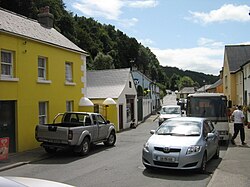Avoca, County Wicklow
|
Avoca Abhóca
|
|
|---|---|
| Town | |

Avoca Main Street
|
|
| Location in Ireland | |
| Coordinates: 52°51′00″N 6°13′00″W / 52.85°N 6.216667°WCoordinates: 52°51′00″N 6°13′00″W / 52.85°N 6.216667°W | |
| Country | Ireland |
| Province | Leinster |
| County | County Wicklow |
| Elevation | 35 m (115 ft) |
| Population (2011) | |
| • Urban | 753 |
| Irish Grid Reference | T201801 |
Avoca (Irish: Abhóca, formerly Abhainn Mhór, meaning "the great river") is a small town near Arklow, in County Wicklow, Ireland. It is situated on the River Avoca.
The Avoca area has been associated with its famous copper mines for many years and the valley has been celebrated by Thomas Moore in the famous song "The Meeting of the Waters". The name of the song derives from the meeting of the Avonmore and Avonbeg rivers, about two miles from the village of Avoca. The song is said to have been written under a tree, the stump of which remains by the Meetings. Avoca is also famous for its handweaving, with Avoca Handweavers based there.
Avoca was once known as Newbridge. It subsequently became known as Ovoca, and then in Victorian times as Avoca. Ptolemy mentions the river Obhoca on his early map of Ireland. The official name of the village is now Avoca in English and Abhóca in Irish. None of the other names are used today.
Avoca has been used as a filming location for several films and television series. The BBC series Ballykissangel was filmed there. In 1967, Avoca was one of the locations used in the film Jules Verne's Rocket to the Moon, and it was the setting for the comedy film Zonad which had a general Irish release in 2010.
The red kite, recently reintroduced to Ireland, is now commonly seen in and around Avoca.
Copper mining is reported to have begun in the Avoca River valley around 1720 and it continued, with interruptions, until 1982. Earlier mining, perhaps dating back to the Bronze Age, may have occurred. The East Avoca site, today, is composed mainly of a number of rock waste spoil heaps, abandoned quarries (Cronebane and East Avoca open pits) and disused roads. The largest spoil heap, Mount Platt, was built up from waste rock excavated from Cronebane open pit. There was a mineral tramway built from the West Avoca mines, through the village (on the opposite side of the river) and on to Arklow Harbour. The route of most of this was subsumed into the Dublin-Rosslare railway line, but an arch and a tunnel under the road from Rathdrum to Avoca remains.
...
Wikipedia

